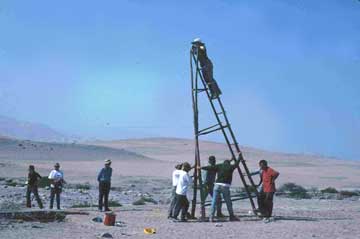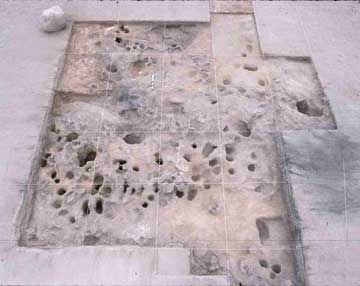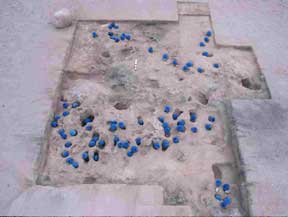Skip navigational links Quebrada Jaguay: Early South American Maritime Adaptations
Principal Investigator: Daniel Sandweiss
Quaternary Graduate Student Participants: Heather McInnis, Benjamin Tanner
Collaborators: Maria del Carmen Sandweiss, David Sanger, Martin Yates (U Maine)
Fred Andrus (University of Georgia); Richard L. Burger (Yale University)
Asuncion Cano (San Marcos University, Peru); Michael Glascock (University ofMissouri)
Michael Malpass (Ithaca College); Lee Newsome (Southern Illinois University)
Bernardino Ojeda (National Agrarian University, Peru); Rolando Paredes (National Institute of Culture, Peru); Dolores Piperno (Smithsonian Tropical Research Institute); Bruce Smith (Smithsonian Institution)

Built on the bank of a seasonal stream on the south coast of Peru, Quebrada Jaguay is the oldest known fishing site in the new world. Archaeological research there by a University of Maine team has shown that the inhabitants were sophisticated fishermen who targeted particular species of fish and shellfish from as early as about 13,000 years ago until about 8000 years ago. From the start, these people built houses (among the earliest known in the New World) and carried out domestic activities such as cooking, finishing chipped stone tools, and so on. During the first occupation, dating to the Terminal Pleistocene, obsidian from the highland Alca source 130 km distant indicates contact with the mountainous interior. Very likely these people moved seasonally between the coast and the Andes. Later, during the Early Holocene, obsidian is much rarer and many sites suddenly appear in the surrounding countryside. By this time, some people may have lived year-round on the coast, moving seasonally from the quebrada bank in the summer when water flows to the foothills in the winter, when dense fog provides water and vegetation. The site and region seem to have been abandoned after 8000 years ago, when many records suggest an extended dry period that lasted for about 4000 years. Though the Quebrada Jaguay site was never reoccupied, others sites in the region date to about 4000 years ago, but their contents suggest a different way of life than at the earlier settlements.
Initial results were published in Science 1998 September 18; 281: 1830-1832.To view the article or the abstract, you will be required to fill out a free registration. Search for Quebrada Jaguay or Sandweiss, D. to find the article.


These photos show postholes from a Terminal Pleistocene house at Quebrada Jaguay, south coast of Peru. #2 has blue balloons in the holes that predate an indurated layer (i.e., holes from the earliest versions of the house).


